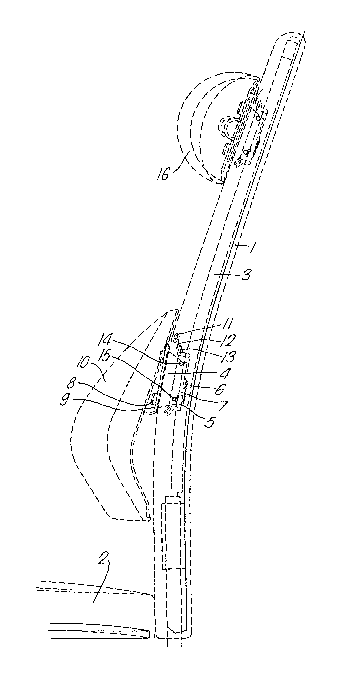Some of the information on this Web page has been provided by external sources. The Government of Canada is not responsible for the accuracy, reliability or currency of the information supplied by external sources. Users wishing to rely upon this information should consult directly with the source of the information. Content provided by external sources is not subject to official languages, privacy and accessibility requirements.
Any discrepancies in the text and image of the Claims and Abstract are due to differing posting times. Text of the Claims and Abstract are posted:
| (12) Patent: | (11) CA 1309009 |
|---|---|
| (21) Application Number: | 1309009 |
| (54) English Title: | ARRANGEMENT IN CONNECTION WITH AN ADJUSTABLE BACK REST CUSHION FOR A CHAIR |
| (54) French Title: | MONTAGE RELIE A UN COUSSIN DE DOSSIER REGLABLE POUR CHAISE |
| Status: | Term Expired - Post Grant |
| (51) International Patent Classification (IPC): |
|
|---|---|
| (72) Inventors : |
|
| (73) Owners : |
|
| (71) Applicants : |
|
| (74) Agent: | GOWLING WLG (CANADA) LLP |
| (74) Associate agent: | |
| (45) Issued: | 1992-10-20 |
| (22) Filed Date: | 1989-09-05 |
| Availability of licence: | N/A |
| Dedicated to the Public: | N/A |
| (25) Language of filing: | English |
| Patent Cooperation Treaty (PCT): | No |
|---|
| (30) Application Priority Data: | ||||||
|---|---|---|---|---|---|---|
|
A B S T R A C T.
An arrangement in connection with an adjustable back
rest cushion (10,16), where the cushion is connected
with a slide means (4,5) which may be moved in a guide
(3) forming part of the back rest (1), said guide (3)
consisting of a contoured rail spaced from the back
rest front, said slide means (4,5) consisting of two
members, viz. a slide member (5) which is designed to
be movable in a groove in said rail, solely in the
longitudinal direction of said rail, and a cushion
holder member (4), which at its rear portion is
pivotably attached (14) to one end of a front portion
of slide member (5), and is lockable by the aid of a
snap lock means (15, 15', 15") to the other end of said
front portion of slide member (5), the front portion of
cushion holder member (4) being provided with means (8)
for engagement with cushion rear side (9).
(Figure 1)
Note: Claims are shown in the official language in which they were submitted.
Note: Descriptions are shown in the official language in which they were submitted.

2024-08-01:As part of the Next Generation Patents (NGP) transition, the Canadian Patents Database (CPD) now contains a more detailed Event History, which replicates the Event Log of our new back-office solution.
Please note that "Inactive:" events refers to events no longer in use in our new back-office solution.
For a clearer understanding of the status of the application/patent presented on this page, the site Disclaimer , as well as the definitions for Patent , Event History , Maintenance Fee and Payment History should be consulted.
| Description | Date |
|---|---|
| Inactive: Expired (old Act Patent) latest possible expiry date | 2009-10-20 |
| Grant by Issuance | 1992-10-20 |
There is no abandonment history.
| Fee Type | Anniversary Year | Due Date | Paid Date |
|---|---|---|---|
| MF (category 1, 5th anniv.) - small | 1997-10-20 | 1997-10-20 | |
| MF (category 1, 6th anniv.) - small | 1998-10-20 | 1998-09-29 | |
| MF (category 1, 7th anniv.) - small | 1999-10-20 | 1999-10-14 | |
| MF (category 1, 8th anniv.) - small | 2000-10-20 | 2000-09-20 | |
| MF (category 1, 9th anniv.) - small | 2001-10-22 | 2001-10-01 | |
| Reversal of deemed expiry | 2003-10-20 | 2001-10-01 | |
| Reversal of deemed expiry | 2003-10-20 | 2002-10-03 | |
| MF (category 1, 10th anniv.) - small | 2002-10-21 | 2002-10-03 | |
| MF (category 1, 11th anniv.) - small | 2003-10-20 | 2003-09-17 | |
| Reversal of deemed expiry | 2003-10-20 | 2003-09-17 | |
| MF (category 1, 12th anniv.) - small | 2004-10-20 | 2004-09-09 | |
| 2004-09-09 | |||
| MF (category 1, 13th anniv.) - small | 2005-10-20 | 2005-09-08 | |
| 2005-09-08 | |||
| MF (category 1, 14th anniv.) - small | 2006-10-20 | 2006-09-08 | |
| 2006-09-08 | |||
| MF (category 1, 15th anniv.) - standard | 2007-10-22 | 2007-09-07 | |
| MF (category 1, 16th anniv.) - standard | 2008-10-20 | 2008-09-15 |
Note: Records showing the ownership history in alphabetical order.
| Current Owners on Record |
|---|
| JAN LADE A/S |
| Past Owners on Record |
|---|
| JAN LADE |
| SVEIN ASBJORNSEN |
| SVEIN ASBJõRNSEN |